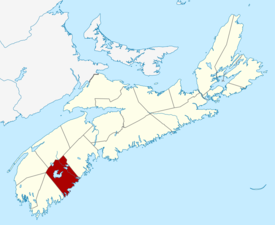| Region of Queens Municipality | |
|---|---|
| Municipality | |
 Coat of arms Coat of arms | |
| Motto(s): Rivers, Forest, Sea | |
 Location of Region of Queens Municipality, Nova Scotia Location of Region of Queens Municipality, Nova Scotia | |
| Coordinates: 44°02′N 64°43′W / 44.033°N 64.717°W / 44.033; -64.717 | |
| Country | Canada |
| Province | Nova Scotia |
| Incorporated | April 1, 1996 |
| Electoral Districts Federal | South Shore—St. Margaret's |
| Provincial | Queens |
| Government | |
| • Type | Queens Regional Council |
| • Mayor | Scott Christian |
| Area | |
| • Land | 2,387.52 km (921.83 sq mi) |
| Population | |
| • Total | 10,422 |
| • Density | 4.3/km (11/sq mi) |
| • Change 2011-2016 | |
| • Census ranking | 400 of 5,162 |
| Time zone | UTC-4 (AST) |
| • Summer (DST) | UTC-3 (ADT) |
| Area code(s) | 902, 782 |
| Dwellings | 6,150 |
| Median Income* | $36,461 CDN |
| Website | regionofqueens.com |
| |
The Region of Queens Municipality is a regional municipality in southwestern Nova Scotia, Canada. It is the northern gateway of the UNESCO Southwest Nova Biosphere Reserve, a centre of outdoor activities. Campgrounds at Kejimukujik National Park and National Historic Site, Thomas H. Raddall Provincial Park, and several other locations offer hiking, biking, canoeing, kayaking, cross-country skiing and snowshoeing. Its seacoast and inland areas are popular photo locations.
Geography
The municipality's boundary includes all of Queens County except for First Nations reserves.
The municipality is 2,760 km (1,070 sq mi), with a diverse geography. Some of its communities are on the Atlantic Ocean's shoreline, while others are further inland; these differences can lead to localized weather patterns. Overall, the municipality's proximity to the ocean provides a temperate climate with mild winters, comfortable summers and a long autumn season.
History
The Region of Queens Municipality was formed in 1996 through an amalgamation of the town of Liverpool and the Municipality of the County of Queens. Its other communities include:
- Beach Meadows
- Brooklyn
- Caledonia
- Greenfield
- Middlefield
- Mill Village
- Milton
- Northfield
- Port Joli
- Port Medway
- Port Mouton
- Western Head
Demographics
In the 2021 Census of Population conducted by Statistics Canada, the Region of Queens Municipality had a population of 10,422 living in 4,977 of its 6,676 total private dwellings, a change of 1.2% from its 2016 population of 10,302. With a land area of 2,387.52 km (921.83 sq mi), it had a population density of 4.4/km (11.3/sq mi) in 2021.
|
|
| Ethnic Origin | Population | Pct (%) |
|---|---|---|
| Canadian | 5,245 | 47.6% |
| German | 3,110 | 28.2% |
| English | 3,005 | 27.3% |
| Scottish | 2,225 | 20.2% |
| Irish | 1,740 | 15.8% |
| French | 1,205 | 10.9% |
| Dutch (Netherlands) | 910 | 8.3% |
| North American Indian | 840 | 7.6% |
Access routes
Highways and numbered routes that run through the municipality, including external routes that start or finish at the municipal boundary:
|
|
See also
References
- ^ "Population and dwelling counts, for Canada, provinces and territories, and census subdivisions (municipalities), 2016 and 2011 censuses – 100% data (Nova Scotia)". Statistics Canada. February 8, 2017. Retrieved February 12, 2017.
- "Population and dwelling counts: Canada, provinces and territories, census divisions and census subdivisions (municipalities), Nova Scotia". Statistics Canada. February 9, 2022. Retrieved March 12, 2022.
- Statistics Canada: 1996, 2001, 2006 census
- Statistics Canada: 2011 census
- 2006 Statistics Canada Census Ethnocultural Portrait of Canada: Queens Regional Municipality, Nova Scotia
- Atlantic Canada Back Road Atlas ISBN 978-1-55368-618-7 Pages 86-87, 90
External links
| Places adjacent to Region of Queens Municipality | ||||||||||||||||
|---|---|---|---|---|---|---|---|---|---|---|---|---|---|---|---|---|
| ||||||||||||||||
| Subdivisions of Nova Scotia | |
|---|---|
| Counties | |
| County municipalities | |
| Regional municipalities | |
| District municipalities | |
| Towns | |
| Villages | |
| Economic regions | |
| Lists | |